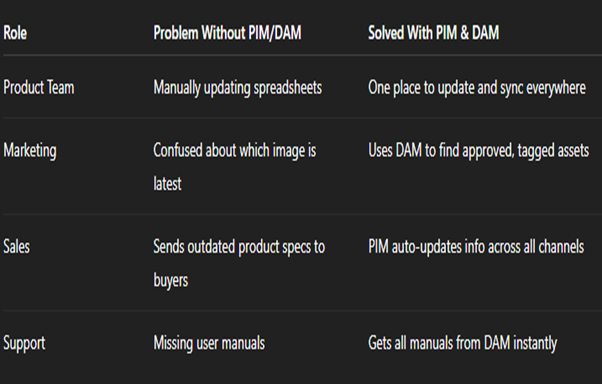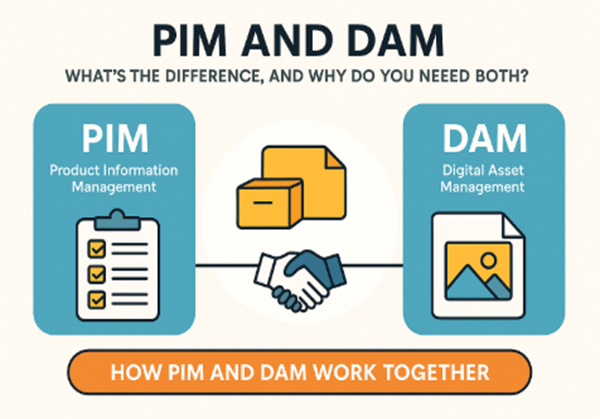What is PIM (Product Information Management)?
PIM is software that centralizes, manages, and enriches product data for marketing and sales across various channels.
Think of PIM as your product data brain:
- Product names, descriptions
- SKU numbers
- Technical specs (size, weight, material)
- Prices and availability
- Localized language info
- Product categorization
- Relationships between products (e.g., bundles, accessories)
Example: You’re launching a new smartphone. The PIM stores all product attributes, prices, models, and variants in one place. From there, you push the data to your website, Amazon, mobile app, and more.
What is DAM (Digital Asset Management)?
DAM is software for storing, organizing, retrieving, and sharing digital assets such as:
- Product images
- Videos and 3D product demos
- Logos and branding assets
- Instruction manuals, PDFs
- Banners, presentations, and campaign creatives
Example: Your marketing team needs the latest banner for a social ad. Instead of checking multiple drives or folders, they open your DAM tool, search by product tag, and download the right image instantly.
Real-Life Example: E-commerce Company
Imagine an e-commerce company launching new kitchen appliances across India, Europe, and the US:

Why PIM and DAM Matter
PIM solves:
- Outdated info on multiple platforms
- Long time-to-market
- Confusion in specs between teams
DAM solves:
- Lost files
- Version control issues
- Inconsistent branding across platforms
Key Differences Between PIM and DAM

How PIM and DAM Work Together
PIM and DAM are most powerful when integrated.
PIM provides:
Product details (e.g., “Red Running Shoes, Size 10”)
DAM provides:
The matching images, videos, and size guides for those shoes
Together:
They deliver a complete and enriched experience—whether you’re building an online catalog, uploading to Amazon, or sharing assets with resellers.
Example: You launch a product in 5 countries. PIM handles multi-language descriptions, while DAM ensures each market gets localized images or region-specific banners.
Business Benefits of Using PIM + DAM
- Faster product launches
- Accurate product listings
- Centralized information hub
- Less dependency on different teams
- Consistent brand experience
- Fewer returns due to incorrect product info
- Improved SEO with enriched metadata
Popular PIM and DAM Tools (2025)

Conclusion: Why PIM and DAM Are Better Together
In today’s digital-first world, managing content and product data efficiently is no longer optional—it’s essential. While PIM helps you organize and enrich product information (like descriptions, pricing, SKUs), DAM stores and manages your visual content (like images, videos, and manuals).
Think of it like this:
PIM tells the story. DAM shows the story.
Together, they empower your teams to:
- Launch products faster across multiple channels
- Provide a consistent brand experience to customers
- Reduce errors and rework
- Improve collaboration across departments (marketing, sales, support, etc.)
By integrating both tools, you create a streamlined digital ecosystem where your data and assets work together, not in silos.
“When your product data and media are always in sync, your business becomes more agile, scalable, and customer-focused.”
